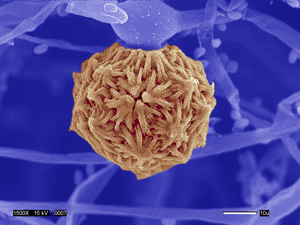Large Fungal Spores Are More Virulent for Immunosuppressed Patients
By LabMedica International staff writers
Posted on 23 Jun 2011
Two different spore sizes of the fungus Mucor circinelloides, a pathogen that kills half or more of its victims, could help to categorize these fungal infections, develop new treatments, and fight other types of fungal infections.Posted on 23 Jun 2011
Scientists at the department of molecular genetics and microbiology, Duke University Medical Center (Durham, NC, USA) demonstrated the new way to categorize fungi. A fungus is typically described through its growth pattern: either fingerlike hyphal growth, like bread mold, or round and symmetric isotropic growth, like an expanding balloon. The scientists at Duke concluded from their study that there is another way to categorize a fungus, by whether it produces larger or smaller spores. The work was published in PLoS Pathogens online on June 16, 2011.

Image: A sexual spore (zygospore) of the human pathogenic zygomycete, Mucor circinelloides. (Photo courtesy of Valerie Knowlton, NC State University).
Mucor infection was in the news as an environmental fungus contracted by people who had trauma in the wake of tornadoes in Joplin (MO, USA). Three out of eight patients had died by June 11. This group of fungi can be common in the environment but only particular hosts with high risks become infected. In Joplin, some people got the fungal infection through traumatic skin wounds.
"Clinically, these mucor infections are reasonably common in diabetic patients, transplant patients, and lung-cancer chemotherapy patients," said Joseph Heitman, MD, PhD, cosenior author and chair of the Duke department of molecular genetics and microbiology, said. "Having a high blood-glucose level is immunosuppressive, and predisposes diabetic patients to difficult-to-manage fungal infections."
Related Links:
Department of Molecular Genetics and Microbiology, Duke University Medical Center









 Analyzer.jpg)




